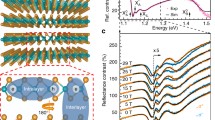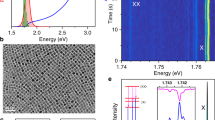Abstract
A large class of new layered semiconductors — lead iodide compounds — is of great interest because of possible optoelectronic applications due to pronounced excitonic effects. These compounds may be regarded as naturally grown semiconductor/insulator superlat-tices, with perovskite lead iodide (semiconductor) layers sandwiched by alkylammonium (insulator) layers. Exciton binding energies and oscillator strength in these structures are enhanced due to the so-called “dielectric confinement“ caused by large difference between dielectric constants of adjoining layers. The binding energies, wave functions, & diamagnetic coefficient of excitons in these naturally grown superlattices are calculated with allowance for the image potential and the superlattice structure of the compounds. The localization of excitons in lead iodide layers causes also a strong dependence of a polariton spike in reflection spectra on the polarization of electromagnetic wave. The results obtained are in agreement with the experimental data.
Similar content being viewed by others
References
S.S. Nagapetyan, Yu.I. Dolzhenko, E.R. Arakelova, V. Koshkin, Yu.T. Struchkov, and V.E. Shklover, Zh. Neorg. Khim., 33, 2806 (1988) [Sov. J. Inorg. Chem., 33, 1614 (1988)].
T. Ishihara, J. Takahashi, and T. Goto, Solid State Commun., 69, 933 (1989).
T. Ishihara, J. Takahashi, and T. Goto, Phys. Rev. B, 42, 11099 (1990).
X. Hong, T. Ishihara, and A.V. Nurmikko, Phys. Rev. B, 45, 6961 (1992).
J. Calabrese, N.L. Jones, R.L. Harlow, N. Herron, D.L. Thorn, and Y. Wang, J. Am. Chem. Soc. 113, 2328 (1991).
G. Lucovsky, {etet al.}., Solid State Commun. 18, 811 (1976)
Y. Nagamune, S. Takeyama, and N. Miura, Rhys. Rev. B40, 8099 (1989).
L.V. Keldysh, Pis’ma Zh. Eksp. Teor. Fiz., vol. 29, pp. 716–719 (1979) [JETP Lett., vol. 29, p. 658 (1979)].
E. Hanamura, N. Nagaosa, M. Kumagai, and T. Takagahara, Material Sci. Eng., vol. B1, pp.255 (1988).
R.R. Guseinov, Phys. Stat. Solidi (b), 125, 237 (1984).
G. Bastard, Wave Mechanics Applied to Semiconductor Heterostructures, Les Editions de Physique, (Les Ulis France, 1988).
E.A. Muljarov, S.G. Tikhodeev, and T. Ishihara, Optical Engineering, 1985 (1993).
L.V. Keldysh, Superlattices & Microstructures, 4, 637 (1988).
C. Xu, H. Sakakura, T. Kondo, S. Takeyama, N. Miura, Y. Takahashi, K. Kumata, and R. Ito, Solid State Commun., 79, 249 (1991).
Author information
Authors and Affiliations
Rights and permissions
About this article
Cite this article
Gippius, N., Muljarov, E., Tikhodeev, S. et al. Dielectrically Confined Excitons and Polaritons in Natural Superlattices–Perovskite Lead Iodide Semiconductors. MRS Online Proceedings Library 328, 775–780 (1993). https://doi.org/10.1557/PROC-328-775
Published:
Issue Date:
DOI: https://doi.org/10.1557/PROC-328-775




